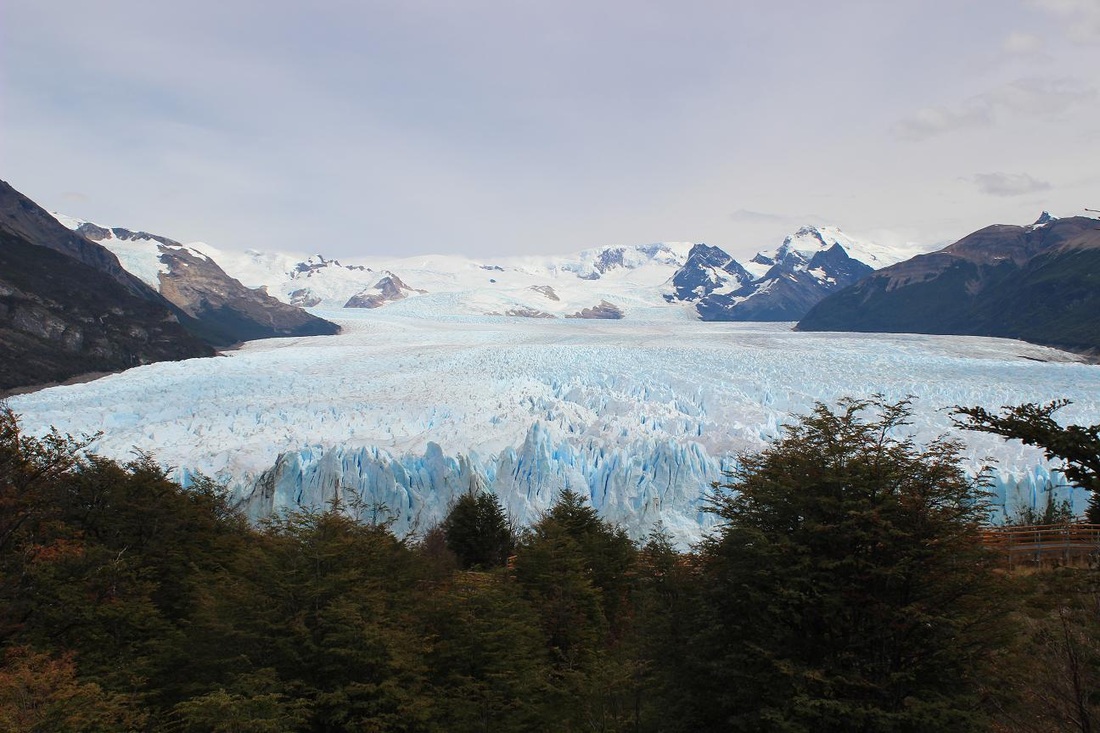
The cold hard facts: 5km wide along its face, 30km long, 170 meters total depth (average 75m above water). One of the few advancing/stable glaciers remaining.An amazing sight to behold!
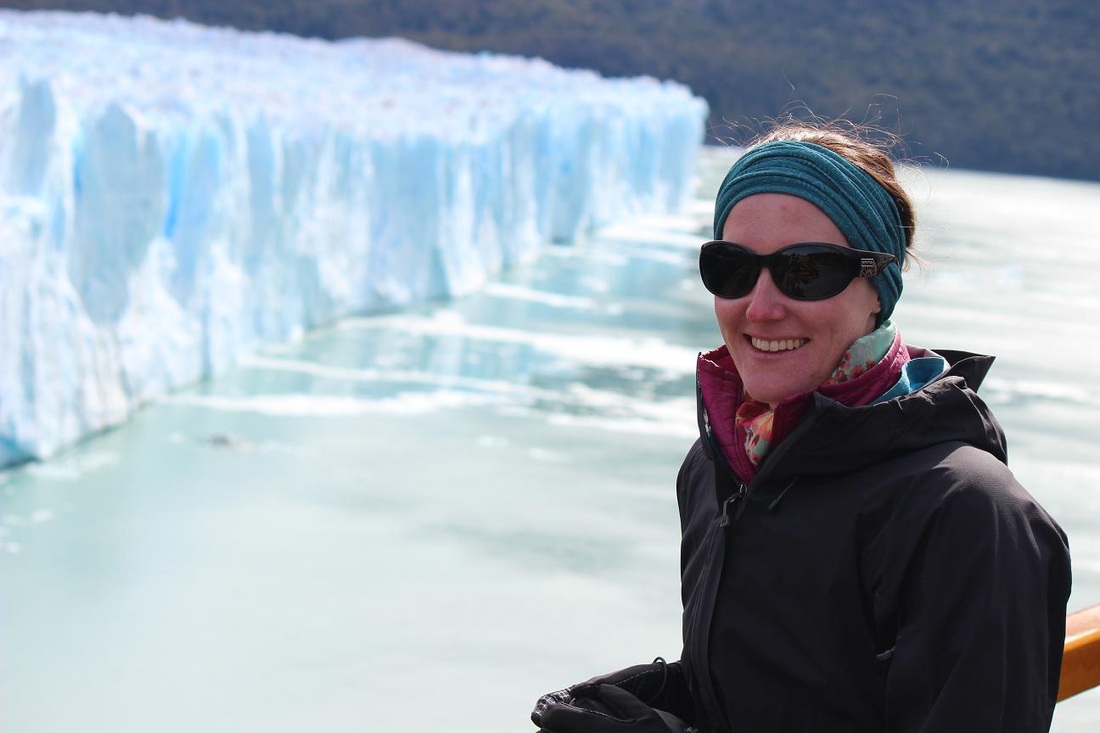
Still smiling after 6 hours watching the ice!
|
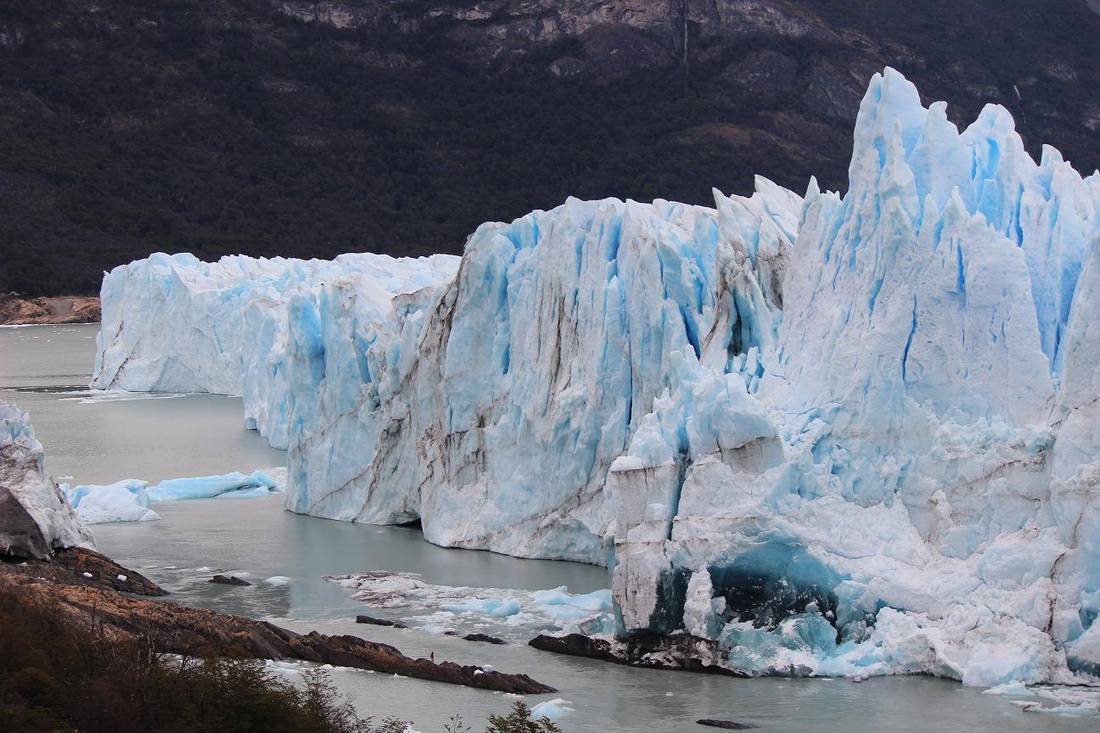
To help give you a bit of perspective on the immensity of this glacier, if you look closely you will see a person standing on the rocks in front of the glacier.
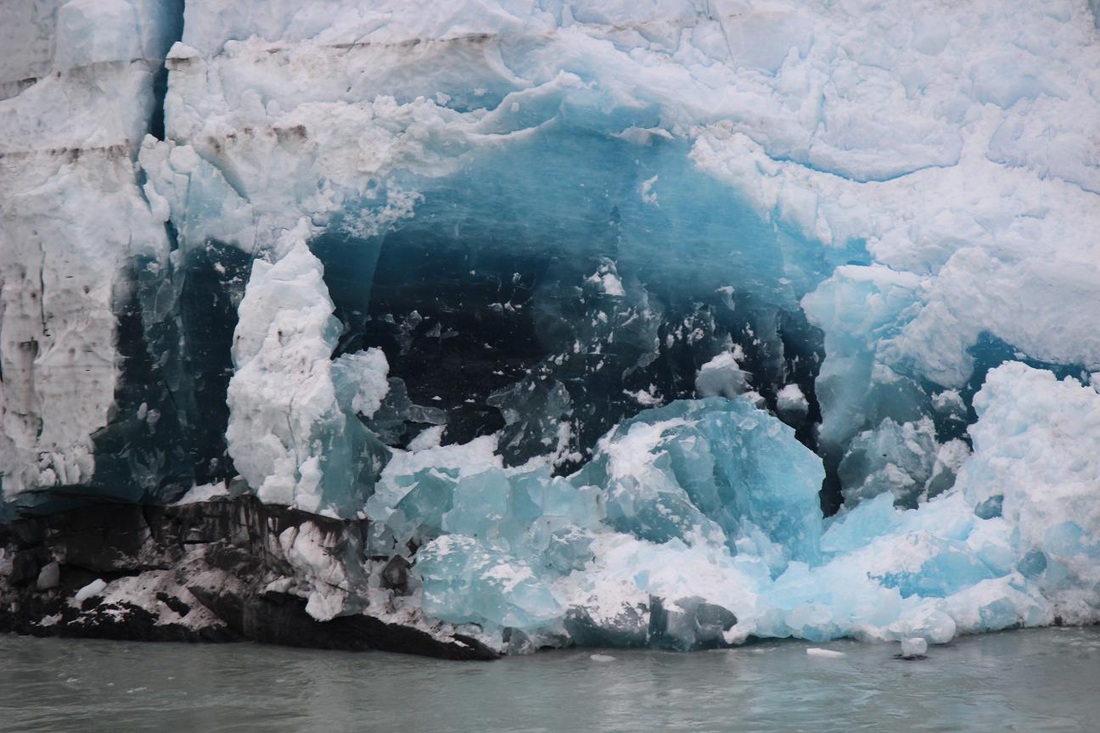
The darker the blue, the more compressed the ice. This is some dense ice!
|
There is really nothing we can say to describe this amazing glacier. We hope our pictures helped to convey some small glimpse of how enchanting it is to watch glaciation in progress.
We spent a rainy 2 nights in Caleta Tortel, a town set in Jurassic Parkesque scenery, immense cliff faces, rainforests, and of course glaciers. In addition to the immense scenery the town is set along a fijord and is built on stilts and boardwalks. In order to get around town we had to navigate the maze of boardwalks along the water and stairs through the hillside, it was a unique experience. We had a bit of trouble getting out of town, but once at the fork in the road it took only 4 minutes to get our next ride. A father and son duo from Valpariso picked us up. They were on a 3 month road trip for the son to see the amazing landscape that his country contains and for the father to collect seeds of all the different native plants. Arriving in Villa O’Higgins we were only mildly surprised to learn of the upcoming rodeo! So our day was spent watching the wauchos (cowboys) perform with glacier covered mountains as a backdrop. Our evening spent drinking pisco and Coke and dancing to the live band in the gymnasium of the school, much to the entertainment of ourselves and the locals I am sure. It was a perfect way to round out our time on the Carretera Austral.
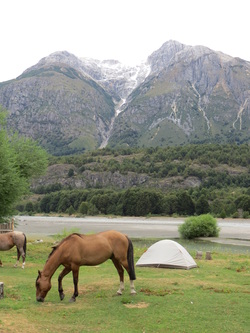
An interesting quirk arising from the remoteness that we sought and found on the Carretera Austral; few banks & few ATMs, even fewer that would accept VISA. Having not accounted for this prior to embarking, we found ourselves low on cash and hence hitching the next 300-odd kilometers. So early on the rainy Monday after the festival we could be found on the only road out of town with our thumbs stuck out. After maybe two hours we struck gold! And to boot it was in the cab of a truck, better than out in the back with the dog in the rain – luxury! It came to pass that our ride, Nelson, had a campsite on his estancia abut halfway to our destination. A quick check of the schedule – open – and we had arrived at our home for the night. The estancia had been in his wife’s family for three generations and her great-grandparents were the original settlers on that land. They were situated on the Nadis Rio surrounded by glacier-coated peaks. The crazy thing is that after all the amazing vistas we had seen we found this place pleasant, but not breathtaking – boy we are spoiled!

The original homestead
During our stay we were fortunate to gain a unique insight into the resourcefulness of the locals that lends itself to their resilience in a harsh environment. As they had just slaughtered two lambs for an Asado (BBQ) that evening we were able to witness them utilizing every part of the animal; the sheep-skin drying in the shed, the heart, lungs, etc smoking over the fire and the rest roasting and dripping its fat and amazing smell of campfire and roasting meat. The pioneering spirit is very much alive here. And I have to admit it has been difficult at times but I have really gained a much deeper knowledge and respect for how and where the meat I eat comes from. We immensely enjoyed the corderro (lamb) that Nelson and Marisol shared with us, amazing Chilean hospitality. The following day we journeyed through adjacent estancias to see the confluence of the Baker and Nadis rivers. Bek spend a bit of time practicing her Spanish with their 15 year old daughter who industriously spends her free time making jewelry and knitted goods. Additionally Bek bought a headband the daughter had made using wool they had spun from their own sheep and dyed with the berries from the Calafate bushes on their property. Talk about getting back to the land, they had one solar panel that generated their electricity, their water was from the stream that ran through their yard and their food came from their kitchen garden and their cattle. In the winter Marisol and their daughter move up to town so the daughter can go to school and Nelson spends the long winter days alone at the Enstancia. Three hours of sunshine a day and the rest darkness and snow, I am truly humbled by the fortitude, industriousness and resourcefulness of the people who live in such an intense and remote part of the world.
After four plus hours of unsuccessful hitch-hiking in Rio Tranquilo we threw in the thumb and hopped the only bus that day down to Cochrane. We treated ourselves to a couple of luxurious nights in a real bed before heading to the hills for a three day trek. Reserva Nacional Tamango contains the largest population of Humules (Andean Deer) in the world. Despite their endangered status we had high hopes for a sighting due to the relatively small size of the reserve. As our luck would have it we did not encounter a single deer during the trip; although we did manage to see a Mink which had caught a fish! We were quite excited until we learned that they are a pest, having escaped from a fur farm decades ago and not doing much to help the Patagonian fauna. Not many people out trekking in the reserve – the guardiaparque actually gave us quite a tough time about going out trekking. As it turns out they were currently searching for a missing hiker. They only found him two days later! We did meet two University students from Conception who were living in the reserve for a month as part of there studies. Their job was to go out trekking each day to search for Huemules. Their colleague had spent January in the reserve and only seen seven. They had been there five days and not only had already seen nine, but also rescued the lost hombre. Pretty good start :) During our three very hot and very dusty days we did manage to enjoy ourselves, despite the lack of wildlife, in large part thanks to icy dips in the lake and reveling in the isolation.
We returned to town in time for the rodeo. Lots of stalls with food and craft and activities such as kids trying to ride sheep and catch greased piglets, men riding calves which had just been branded and a ‘traditional’ game that looked suspiciously like hop-scotch. All-around great fun! Less enjoyable was the conditions in the campground. There was only one campground in town and everyone was there. Twenty-seven tents on top of each other, two showers with limited operating hours, and one toilet, seat not included!!!! Needless to say we got out of there pretty fast.